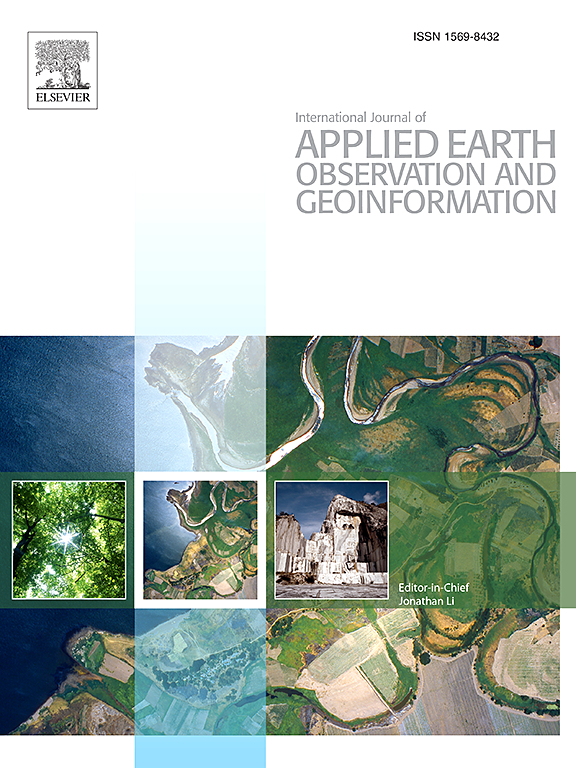基于洪水指数增强的深度学习模型在SAR影像中进行海岸淹没制图
IF 7.6
Q1 REMOTE SENSING
International journal of applied earth observation and geoinformation : ITC journal
Pub Date : 2025-04-19
DOI:10.1016/j.jag.2025.104550
引用次数: 0
摘要
本文介绍了一种利用双极化和双时相Sentinel-1合成孔径雷达(SAR)图像的洪水指数增强深度学习模型,用于沿海淹没制图。所提出的模型FIE-Net引入了两项关键创新,以提高洪水制图的精度。首先,它整合了基于双时相SAR数据的主要洪水指数Ratio Image (RI),为精确划定淹没区域提供了可靠的参考。该指数提供了一个清晰的、特定于洪水的信号,提高了分割精度。其次,该模型采用双分支U-Net框架,增强了专用模块,增强了特征提取,更好地集成了不同的数据源。这种组合使模型能够更有效地处理复杂的洪水情景,从而提高整体性能。利用哥白尼应急管理服务的数据,在不同地形条件下收集了马达加斯加热带气旋2018 AVA和2023 Cheneso的16对代表性SAR图像。经过半自动标注和裁剪后,共处理了4350对样本,其中2784/696/870对用于模型训练/验证/测试。所提出的模型达到了79.44%的十字路口(IOU),在所有评估指标上都优于最先进的模型。实验还表明,每一项引入的创新都有助于提高准确性,其中洪水指数的影响最为显著。此外,利用Cheneso事件的三个独立洪涝区(689个样本,未包括在训练中)进一步验证了模型的适用性。在所有三个场景中,欠条均超过75%,强调了模型在实际场景中的可靠性和鲁棒性。本文章由计算机程序翻译,如有差异,请以英文原文为准。
Flood Index-Enhanced deep learning model for coastal inundation mapping in SAR imagery
This study introduces a flood index-enhanced deep learning model for coastal inundation mapping leveraging dual-polarization and bitemporal Sentinel-1 synthetic aperture radar (SAR) imagery. The proposed model, FIE-Net, introduces two key innovations to improve flood mapping accuracy. First, it integrates the Ratio Image (RI), a primary flood index derived from bitemporal SAR data, which provides a reliable reference for precise inundation area delineation. The index offers a clear, flood-specific signal that enhances segmentation precision. Second, the model employs a dual-branch U-Net framework, augmented with specialized modules to enhance feature extraction and better integrate diverse data sources. This combination enables the model to handle complex flood scenarios more effectively, thereby boosting overall performance. Using data from the Copernicus Emergency Management Service, 16 pairs of representative SAR images from Madagascar’s Tropical Cyclones 2018 AVA and 2023 Cheneso were collected under various terrain conditions. After semi-automatic labeling and cropping, 4350 sample pairs were processed, with 2784/696/870 used for model training/validation/testing. The proposed model achieved the highest Intersection over Union (IOU) of 79.44%, outperforming the state-of-the-art models across all evaluation metrics. The experiments also demonstrate that each introduced innovation contributes to improved accuracy, with the flood index making the most significant impact. Furthermore, the model’s applicability was further confirmed with three independent flooded areas (689 samples, not included in training) from the event Cheneso. IOUs in all three scenes consistently exceeded 75%, underscoring the model’s reliability and robustness in real-world scenarios.
求助全文
通过发布文献求助,成功后即可免费获取论文全文。
去求助
来源期刊

International journal of applied earth observation and geoinformation : ITC journal
Global and Planetary Change, Management, Monitoring, Policy and Law, Earth-Surface Processes, Computers in Earth Sciences
CiteScore
12.00
自引率
0.00%
发文量
0
审稿时长
77 days
期刊介绍:
The International Journal of Applied Earth Observation and Geoinformation publishes original papers that utilize earth observation data for natural resource and environmental inventory and management. These data primarily originate from remote sensing platforms, including satellites and aircraft, supplemented by surface and subsurface measurements. Addressing natural resources such as forests, agricultural land, soils, and water, as well as environmental concerns like biodiversity, land degradation, and hazards, the journal explores conceptual and data-driven approaches. It covers geoinformation themes like capturing, databasing, visualization, interpretation, data quality, and spatial uncertainty.
 求助内容:
求助内容: 应助结果提醒方式:
应助结果提醒方式:


